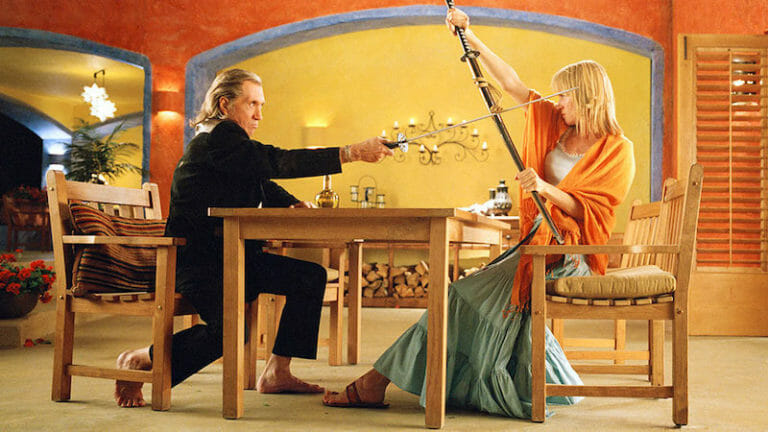By Ken Miyamoto · November 18, 2019

What is it about Quentin Tarantino dialogue that separates itself from other screenplays — and how can screenwriters apply that type of dialogue to their own stories?
Welcome to our ongoing Learning from the Masters and Industry Insiders series where we seek out and feature excellent videos, interviews, and discussions of the art, craft, and business of screenwriting and pull the best words of wisdom, writing tips, and screenwriting advice.
Here we turn to Tarantino Dialogue — How Kill Bill Keeps Us Hooked as we pull the best points from their video and offer some of our own elaborations. Visit StudioBinder here.
The video shares three specific elements that are consistent within the dialogue of Quentin Tarantino’s screenplays and films.
“The stakes need to be high. And we should know what’s at risk going into each scene.”
Every scene within your screenplay needs to matter. For them to matter, there needs to be conflict. And the best conflict comes from placing characters within the scene in high-stake situations.
Tarantino is a master at presenting such stakes in every great dialogue-driven scene.
The opening dialogue in Pulp Fiction leads to a robbery. Will they be successful or get caught? Will they kill anybody in the process or be killed themselves?
The opening dialogue in Inglorious Basterds showcases a Nazi hunting for Jews. Is the farmer hiding Jews on his property? Does this evil Nazi know?
The pivotal reunion between the Bride and Bill in Kill Bill Vol. 2 features dialogue amidst her rage, his coolness, and the nearby presence of her daughter. Will the Bride finally succeed in killing Bill? Will he kill her? Will he kill her daughter to spite her?
Having high stakes amidst dialogue scenes increases the tension and further engages the reader or audience by keeping them at the edge of their seats reading or listening to every word.
“Every scene should have a beginning, middle, and end. The longer your scene, the more important these divisions and shifts become.”
If every scene should matter within your script, then each of those scenes needs to have structure. The three-act structure of beginning (Act 1), middle (Act 2), and end (Act 3) will help drive those high stakes mentioned above.
The video features this iconic scene in Kill Bill Vol. 2 as an example — the reunion of the Bride and Bill.
Act 1 is primarily physical, with the Bride making her entrance and looking for a way to engage Bill. It ends when he shoots her with the dart that paralyzes her. She has lost any control of the moment.
Act 2 is intellectual, focusing on the long Tarantino-type dialogue we love. He tells an anecdote about comics and wraps all of that into how it points to the Bride’s true character.
Act 3 is the resolution of that. What is the bride going to do? What can she do? What is Bill going to do? And her true character is revealed as a result of the two acts of the scene that came before it.
Give structure to your dialogue scenes. That’s how you keep the audience invested in the words.
“Let your character tell a story.”
Tarantino movies are known for the anecdotes that his characters share. And those anecdotes aren’t just there to sound cool or unique. They usually point to parallels between the anecdotes and the stories or characterizations within the film.
If we go to the extreme anecdotes and character exchanges found within Tarantino’s movies — those that at face-value may not seem connected to the story or characters arcs — we’d look no further than the classic opening dialogue sequence found within Reservoir Dogs.
The dialogue may seem random and pointless to some searching for a connection to the story and characters, but there’s a point to this scene and its anecdotes and dialogue.
Tarantino is — consciously or unconsciously — allowing us to relate to these men. At first, it seems like a group of friends or co-workers having breakfast together. We slowly learn that there’s something more about these characters when Joe jokingly instructs Mr. Blonde to shoot Mr. White.
But because of the opening dialogue exchange where these men are debating the meaning behind Madonna songs, we relate to them. We’re invested. They bring up interesting points and anecdotes that any average man or woman could be discussing across the table from friends, family members, and peers.
And anecdotes can also delay the inevitable, leaving us waiting on each and every word because we know something bad is going to happen. Look no further than Pulp Fiction as an example.
We know the stakes before Jules goes into his rant and biblical passage. The dialogue is delaying the inevitable. He’s going to kill Brett. We know that. Jules knows it. Brett probably knows it too. But Tarantino keeps the tension going to a boiling point before the inevitable kill.
If you want your dialogue to pack the extra punch that Quentin Tarantino offers within his screenplays and films, consider raising the stakes, employing three-act structure, and using anecdotes in each dialogue scene you write.
Watch the StudioBinder video below for details and breakdowns of these points!
Read More: 10 Movies with the Best Dialogue and Famous Movie Quotes